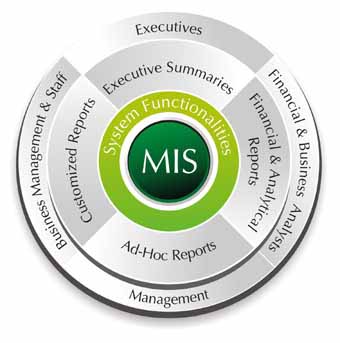AutoMIS - MIS and Information Retrieval System
AutoMIS is a comprehensive reporting tool which forms the backbone for all of our complementing systems reporting. The system is used to generate management, central bank and other statutory reporting requirements in addition to the customized reports for internal purposes. The system facilitates financial analysts and information workers with a high level of flexibility through its parameterization so that they need not depend upon a programmer to define individual reports.

Saves Time -Â AutoMIS saves time by automating reports for instant delivery. Reports are sent from host systems to end user in seconds. Email subscriber lists ensure report delivery by eliminating the potential for human error.
Saves Money -Â AutoMIS drastically reduces company overall cost of reporting by eliminating the need to expend resources on paper, printer maintenance, ink, and the shipping and postage required for printed report delivery.
Performance -Â The core objective of the AutoMIS architecture is to optimize processing time. AutoMIS can process current standard reporting much faster than distributed reporting engines can and scales effectively as data volumes grow.
System Functionalities
Data Extraction and Population -Â AutoMIS is a host based data extraction and database population engine. Critical to any analysis or decision making process are the availability, quality and relevance of the data inputs. AutoMIS improves the quality and relevance of a database or data mart by freeing critical operational detailed data from multiple sources. For this AutoMIS database is designed as an OLAP Database. The system extracts data from the AutoBANKER core banking system database (which is an OLTP database) on a user definable schedule or manually if needed. This extraction and population (data import and export) process can be performed using database to database communication or via a text file(s).
Report Setup -Â Report structure is defined here, including the report presentation, which type of data will be displayed on specified report lines and columns, and how the system will calculate and display various values. It includes parameters related to reports such as line definitions, the number of columns a report will have and the line mapping to the specific data rules including addition, subtraction, division, totals etc.
Lines Definition -Â Line definition classifies the source of data which will be displayed on a line of a particular report i.e. from which branch of the banks data the value will come from and how it will calculate and display various values.
Column Definition -Â Column definition classifies the source of the value which will be displayed in a particular column of a report. This includes definitions of computed values in a column derived through processing and calculations on previous column values.
Customer Analysis -Â Based upon user defined data tagging against a customer for industry, sector, segment, group, business group or sales groups, financial analysts and information workers can analyse the banks portfolio for deposits as well as advances for future forecasting. Managers can also monitor the performance of the relationship managers (RM) or RM Groups.
Adjustment Entries -Â When reports are processed after data extraction, processed values cannot be changed. Where permitted by the system administrator (in report setup parameters), if changes are required on a report column or specific line, adjustment values are defined here. The system picks these adjustment entries when re-processing the report.
Manual Entries -Â When reports are processed after data extraction, processed values cannot be changed. If it is required to print a fixed amount on a report column against a specific line, the value is manually input here. Manual entries differ from adjustment entries in that the system takes manual values as is and prints them on the report without performing any computations on them. Manual entry columns are not allowed to have further adjustments.
Reports Processing -Â This is one of the core features of the AutoMIS system whereby users can define the set of reports that need to be processed overnight using an automated scheduler. A dynamic and comprehensive report processing mechanism converts this raw data into information (i.e. reports) as required by the financial analysts and information workers e.g. consolidation at bank, region or unit wise, etc.
Automated or Manual Report Shipping -Â The AutoMIS Administrator has the ability to schedule the list of reports that need to be shipped after report processing to the end user. The administrator can track all delivered and un-delivered reports and can also send reports manually in case of special requests.
Output formats -Â AutoMIS is able to save reports in multiple output formats including ASCII text, Excel, CSV and PDF.






